5 Kanban Board Software Tools Worth Considering in 2025
Discover the top 5 Kanban board software tools to boost your productivity in 2025, perfect for iOS users managing tasks, goals and projects.
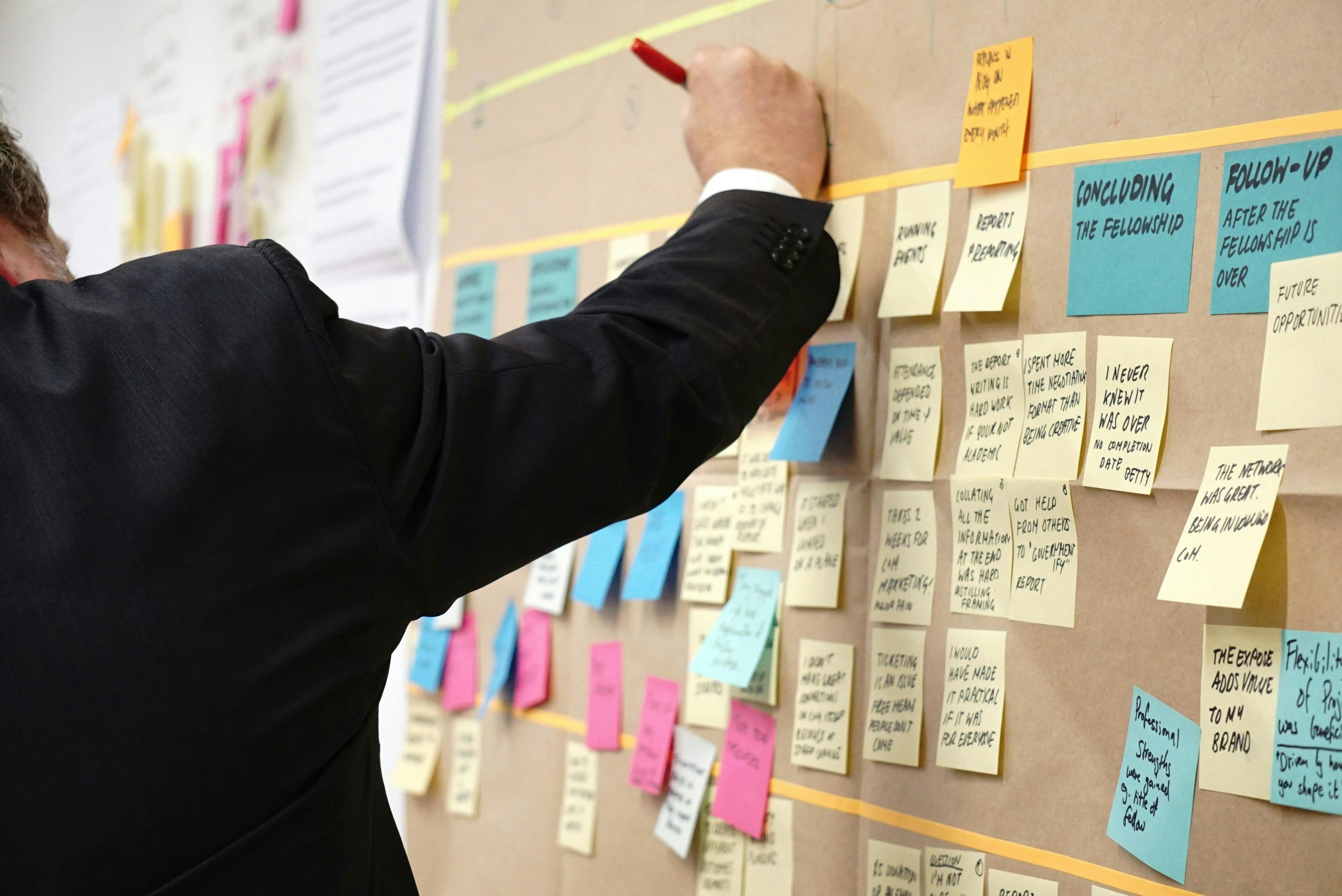
A good Kanban board can make all the difference in how well you juggle work projects and personal goals.
That’s why we tested plenty of them and picked the top 5 Kanban board software options worth your attention in 2025, especially if you're an iOS user who loves a smooth experience.
We focused on tools that are:
- iOS-friendly (think native apps or great mobile support)
- Easy to use
- Great for individuals or small teams
- Well-supported and regularly updated
- Free or offer good value for their features
The best Kanban board software tools: side-by-side comparison
| App Name | Key Features | Use Cases |
|---|---|---|
|
| |
Trello |
|
|
Zenkit |
|
|
Jira |
|
|
Monday.com |
|
|
1. NotePlan
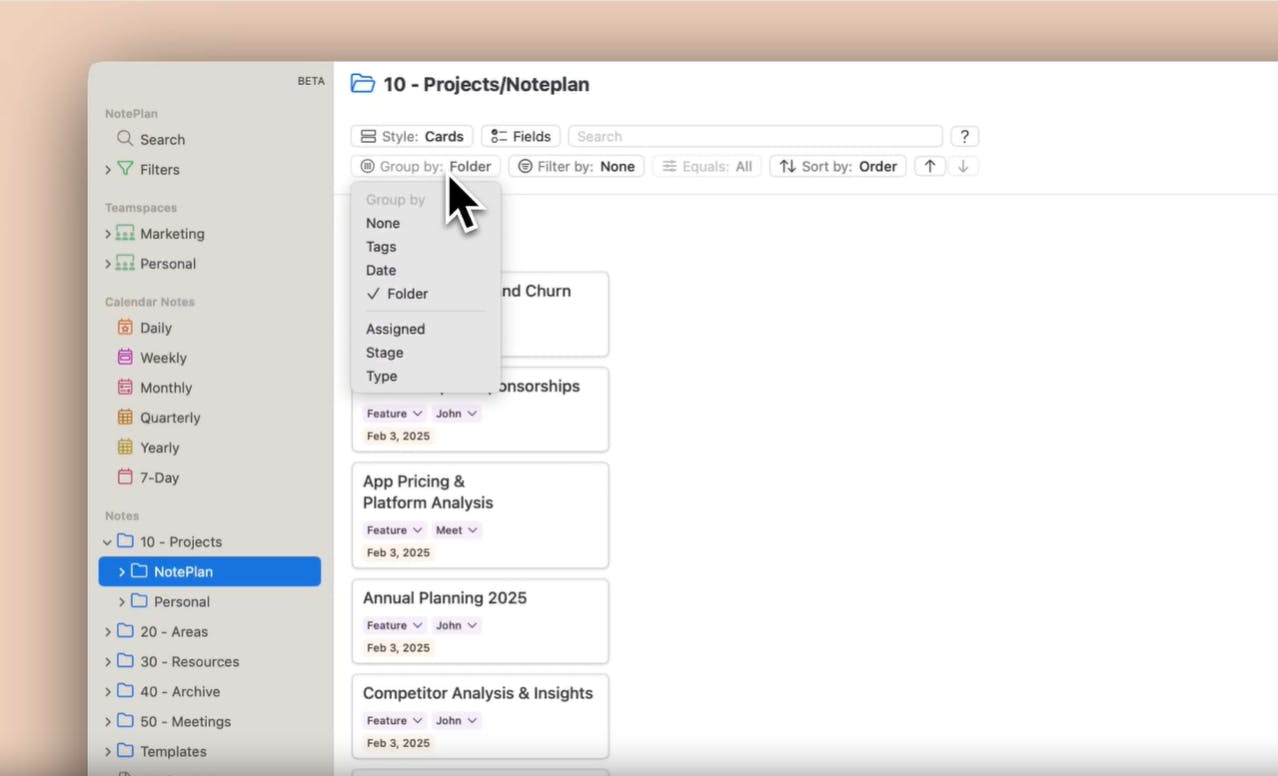
Source: Noteplan.co
NotePlan isn't a typical Kanban app. At its core, it's a note-taking and planning tool built for Apple users (and a great Trello alternative) with a polished, clean interface.
NotePlan syncs across all Apple devices: you can brainstorm on your Mac, review tasks on your iPhone during a commute, or plan your week on an iPad; everything syncs via iCloud. You're never out of sync with your Kanban system.
The Kanban-style system in NotePlan is flexible and built around Markdown notes and linked tasks. Instead of traditional cards and columns, you can create task lists that act like a digital Kanban board, using tags (like #todo, #doing, #done) or custom headers to organize your workflow. You can drag tasks between categories and because it's all text-based, it's lightweight and easy to tweak to your style.
Here's how NotePlan's Kanban Board works:
- Create sections like To-Do, In Progress and Done in any note.
- Use bullet points or checkboxes to list your tasks.
- Move tasks between sections by copy-pasting or dragging.
- Use filters and backlinks to track tasks across multiple notes and projects.
- Syncs across all your Apple devices.
See how easy it is to use Kanban in NotePlan with our video tutorial!
If you like combining your daily notes, calendar and Kanban principles in one simple user interface, NotePlan is your perfect match.
NotePlan features
NotePlan is one of the best AI apps for note-taking with well-developed and easy-to-tweak Kanban features, and additions that go beyond what plain Kanban apps usually offer:
- Linked tasks across notes and projects: Tasks can be linked across notes and calendar days: you can move a task from a project note to your daily to-do list without losing track of where it came from.
- #Tags and @mentions allow dynamic sorting: Create custom Kanban categories with searchable and filterable #tags. Use the mention (@ symbol) followed by a name, keyword, or date to create a link or reference.
- Drag and drop reordering: NotePlan lets you quickly shuffle tasks around like moving a card on a traditional Kanban board.
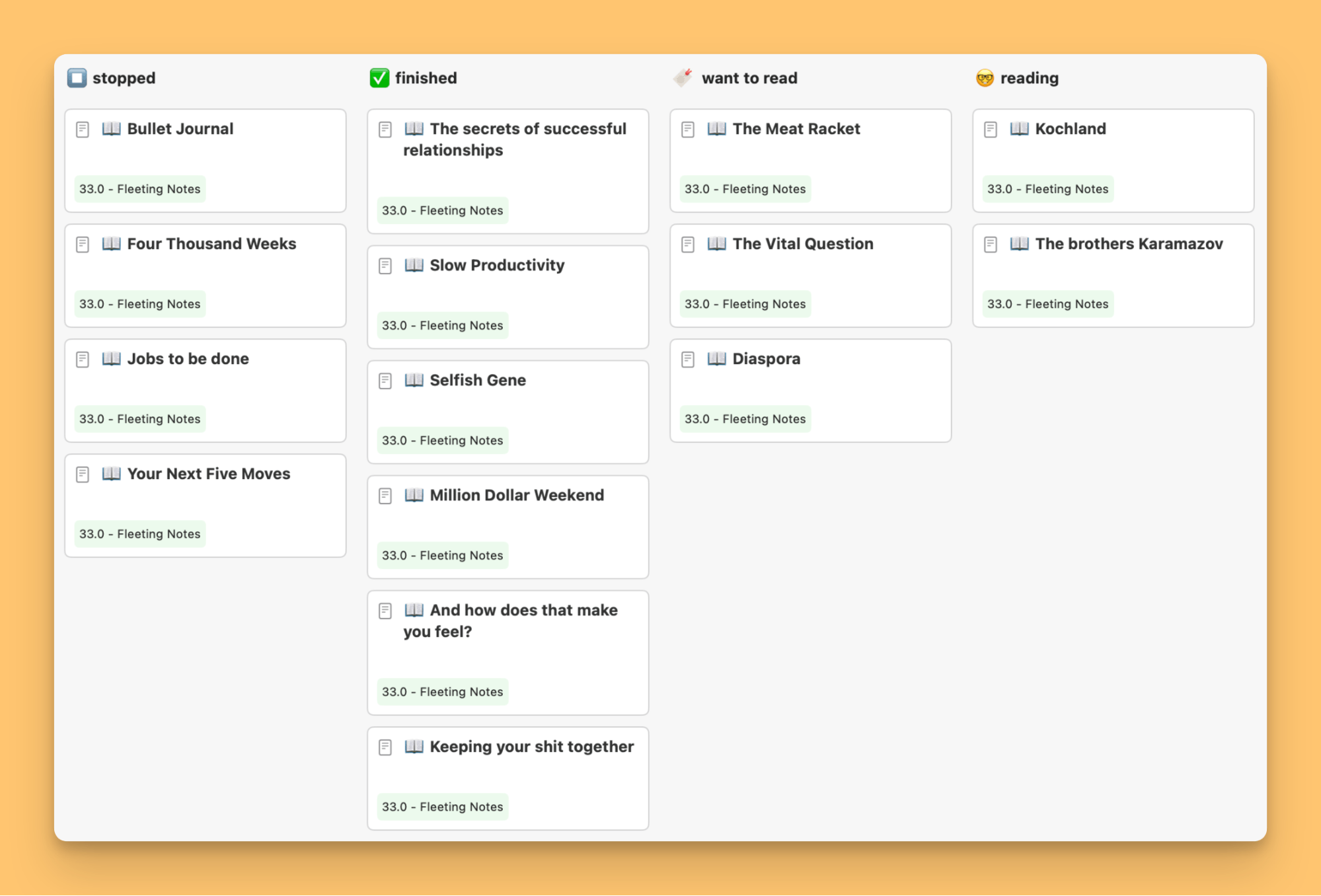
Source: Noteplan.co
- Calendar integration: NotePlan’s built-in calendar lets you schedule tasks directly into your day; you can drag tasks from a Kanban project to a date of choice.
- Filters: Filter tasks by tag, project, date, or completion status: this gives you dynamic Kanban views without needing a separate board for every workflow.
- NotePlan AI: NotePlan has a built-in AI assistant to help you write better notes, summarize long text and brainstorm tasks or ideas. It's especially handy for breaking down big projects into smaller steps; perfect for populating your Kanban board with actionable cards.
- Plugins for custom workflows: NotePlan has a collection of community-built plugins, so you can customize your workflow, automate routines, or add extra features like habit trackers, time logs, or advanced reporting.
You can get started faster with NotePlan by using our business and project management templates. Plus, here's a daily workflow template for busy founders and directors who want to get the absolute most out of their day.
Use cases
NotePlan is perfect for:
- Busy creatives and business owners who like to combine daily journaling and to-do lists all in one place.
- Freelancers juggling multiple clients or projects who need to personalize their Kanban boards and keep work visible and organized.
- Apple fans looking for a fast, native app experience.
- Teams who use Kanban but prefer the Markdown system, with text-based, backlinking system.
- Minimalists with ADHD who want a lightweight, adjustable Kanban that doesn’t muddy the waters.
If you're looking for tools that support focus and structure, check out our roundup of ADHD-friendly apps designed to help you stay organized without feeling overwhelmed.
Reviews
⭐: App Store (4.8/5)
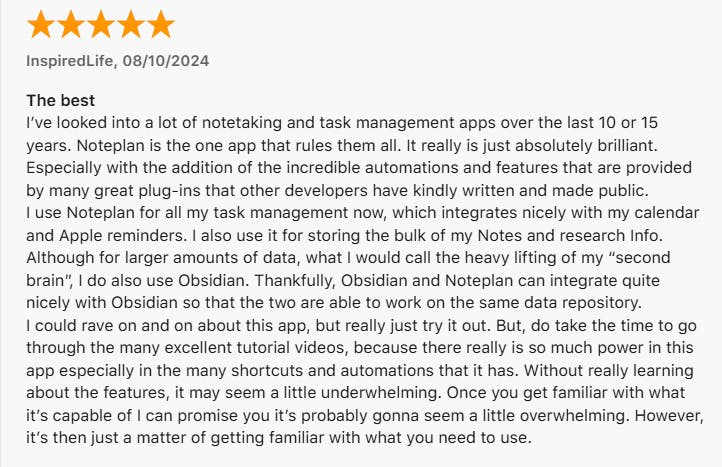
Source: Apple.com
Pricing
- Annually: $8.33 per month ($99.99 billed annually)
- Monthly: $12 per month
Start your 7-day free trial today and see how clean and beautiful your Kanbans can get, without sacrificing any of the features!
2. Trello
A digital kanban pioneer, Trello is well-known and loved for being tidy and straightforward, providing a fuss-free work organization system. It’s available on iOS, macOS, Android, Windows, and the web.
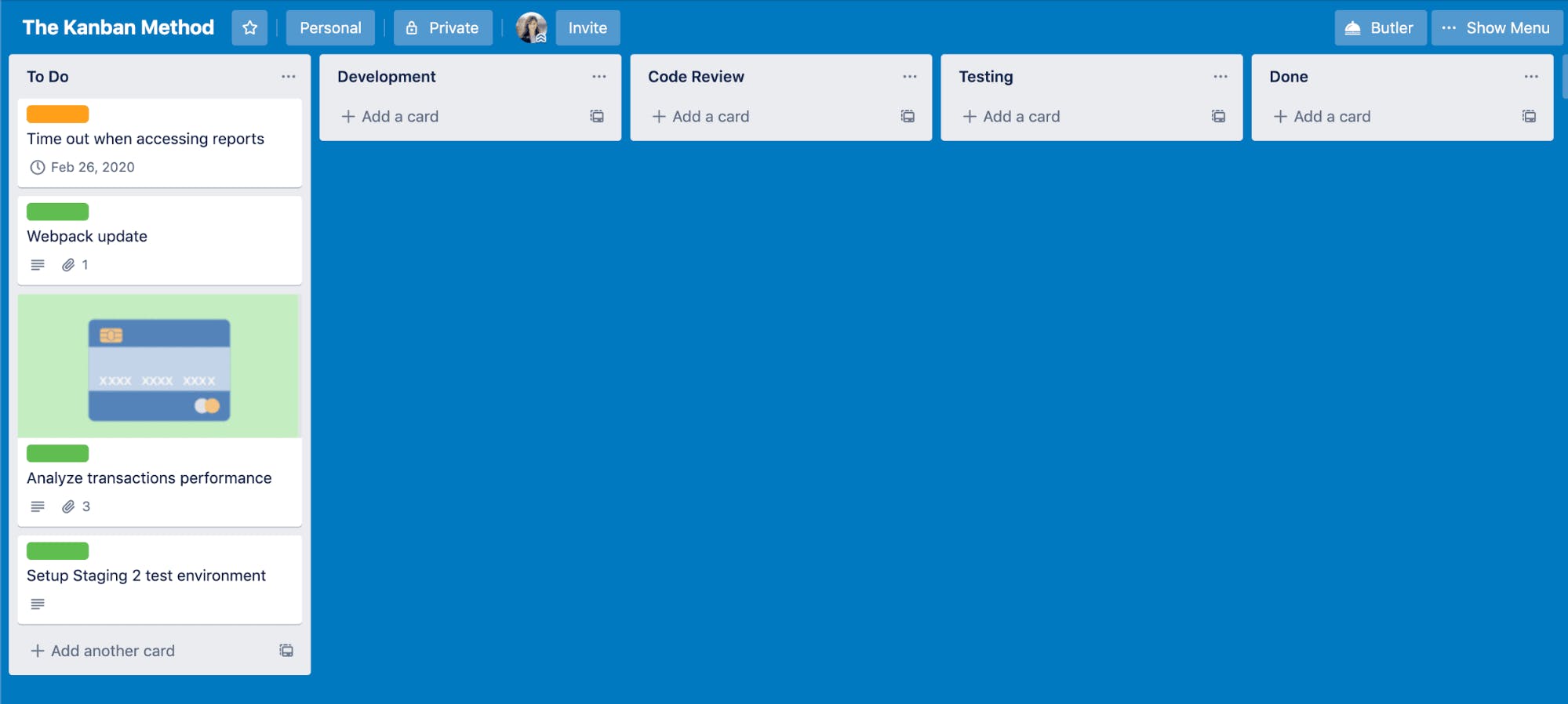
Source: Atlassian.com
Trello features
Trello offers various features that help you go way beyond basic to-do lists and tasks. Here are some of them:
- Drag and drop cards: You can quickly move the cards between lists; cards can include due dates, checklists, attachments, labels and comments
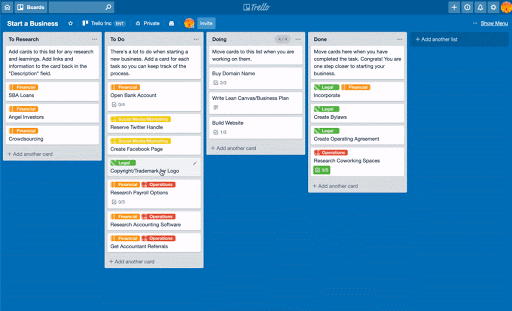
Source: Atlassian.com
- Labels and color coding: Use color-coded labels to group tasks by priority, category or project
- Checklists within cards: Each card can contain its own checklist, making it easy to break down bigger tasks into smaller steps
- Card templates: Save time using card templates for repetitive tasks
- Integrations: Trello Power-Ups let you extend your board with tools like Google Calendar, Slack, Evernote and more
- Butler automation: The app's built-in automation tool, Butler, can perform actions for you, like moving cards, adding labels, or sending reminders based on specific triggers
Use cases
Trello is a beginner-friendly tool that works for all kinds of users:
- Small teams with only a couple of teammates working on a project
- Content managers, creators, bloggers and marketers can use Trello to organize editorial workflows
- Agile project managers that steer clear of complex software like Jira and Asana — Trello provides a much simpler experience
- Students who manage coursework, reading lists and group projects
Reviews
⭐: G2 (4.4/5)

Source: G2.com
Pricing
- Free
- Standard: $5/user/month (for small teams)
- Premium: $10/user/month (for teams managing multiple projects)
- Enterprise: from $17.50/user/month (for large organizations needing extra security and controls)
3. Zenkit
Zenkit is a project management tool that lets you customize how you view and organize your tasks, including a Kanban board. The tool's design allows you to manage personal goals and complex team workflows.
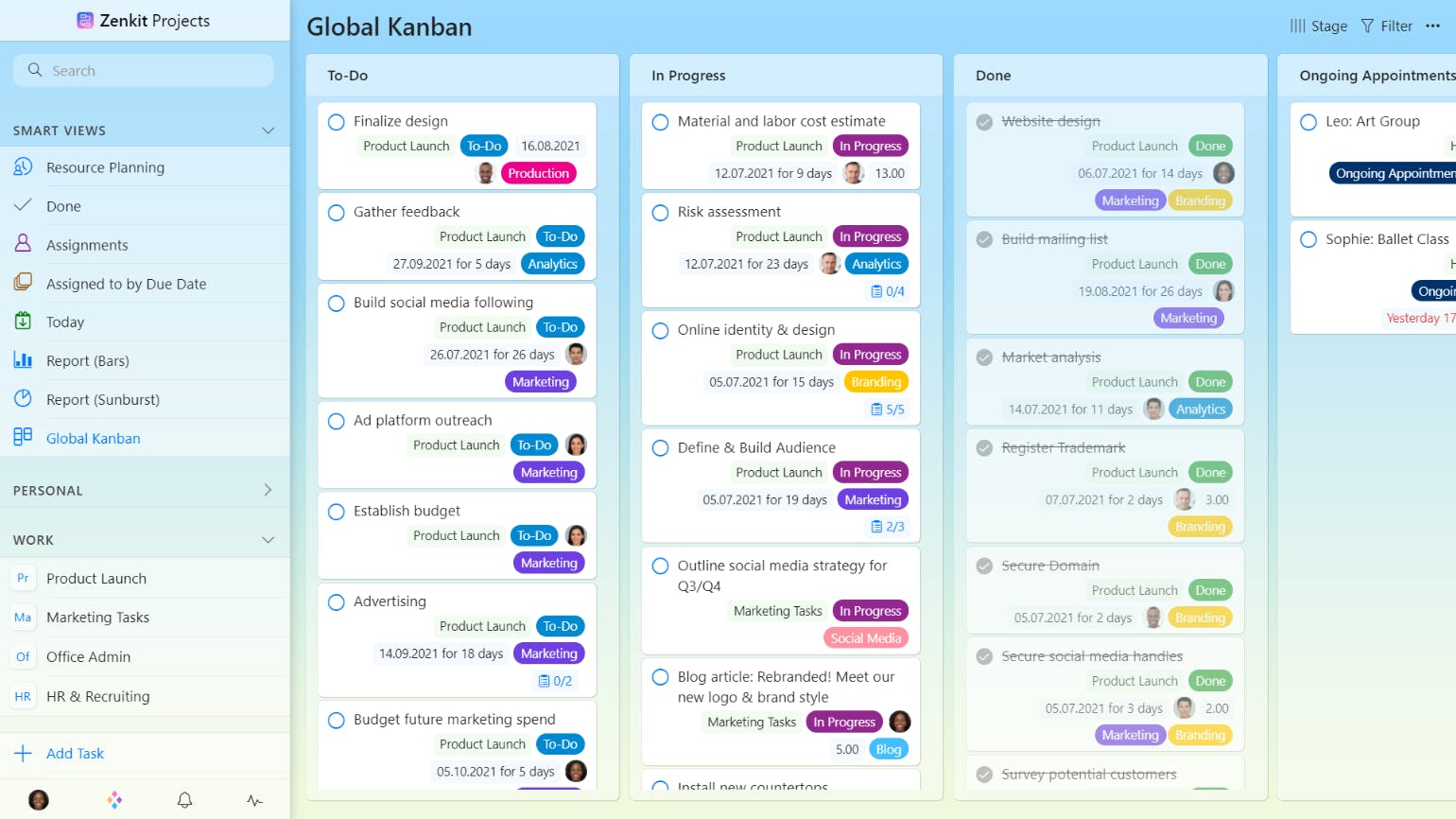
Source: Zenkit.com
Zenkit uses workspaces (called Collections) where you can manage tasks visually using the Kanban method. You can create lists (columns) for project stages and create drag and drop tasks (called items) to move them across stages. You can add details to tasks like due dates, checklists, labels, comments and attachments.
It’s available on iOS, macOS, Windows, Linux, Android and the web.
Zenkit features
- Multiple views with real-time sync: You can start in Kanban view, then switch to Table, Calendar, Gantt, Mind Map, or List view, without losing your data

Source: Help.zenkit.com
- Custom fields: If you need to track task priority, effort, estimated time, or category, you can add your own custom fields to each card (task) and sort accordingly.
- Smart filtering and grouping: Zenkit lets you group and filter tasks by any property, like due date, assignee, label, etc.
- Hierarchies and subtasks: You can nest tasks inside other tasks or create parent-child relationships.
- Collaboration tools: Each task supports comments, mentions (@teammate) and file attachments.
- Offline access and sync: You can work offline on your iPhone or iPad and Zenkit syncs everything automatically when you're back online.
- Templates: The tool has built-in Kanban templates for project planning, product development, weekly tasks, or you can create your own
Use cases
Zenkit is a great fit for anyone who wants more than just a basic Kanban board:
- Solo pros, freelancers and consultants that need to keep client work, deadlines and deliverables in one place
- Remote teams and startups who need structure, but not rigid workflows
- Content creators and marketing teams who use an editorial workflow
- Students: task nesting and hierarchy make it useful for students managing essays, group work, or study schedules
Reviews
⭐: G2 (4.7/5)

Source: G2.com
Pricing
- Personal: Free (for individuals managing simple projects)
- Plus: $8/seat/month (for freelancers and small teams)
- Business: $21/seat/month (for growing teams needing advanced features)
- Enterprise: Custom pricing (for large organizations with specific needs)
4. Jira
Jira is a go-to tool for Agile teams, developers and product managers. The tool's Kanban boards offer a structured way to manage tasks, projects and progress, especially in IT and for complex work with many layers.

Source: Atlassian.com
The app is available on iOS, macOS, Windows and Android.
Jira features
Jira's Kanban functionality is customizable and automation-ready, no matter if you're managing a dev sprint or organizing a personal project:
- Custom workflows and workflow control: Jira Kanban boards are built for continuous improvement. Tasks are called "issues" in Jira and you can move across the board as you make progress. You can also tailor your board to match your exact process (add or rename columns, define custom statuses, etc).
- Work-In-Progress (WIP) limits: Set limits on how many tasks can be in one column at a time
- Issue details and subtasks: Each task card contains everything you need, like description, priority, assignees, labels, attachments, due dates and subtasks
- Swimlanes and quick filters: Use swimlanes to visually separate work by assignee, priority, or project
- Automation rules: Create automations with "if-this-then-that" logic. For example, move an issue to "Done" when all subtasks are completed.
- Analytics and reporting: Built-in reporting gives you real-time insights into your automated workflow
If you're juggling multiple responsibilities, this guide on managing several parallel projects offers smart strategies to stay organized and focused without burning out.
Use cases
Jira has a reputation as a developer's favorite, but its Kanban functionality makes it useful for various users:
- Agile software teams; as Jira was originally built for dev teams it works for Agile workflows
- Product and Project Managers who manage complex, cross-functional projects and need exceptional organization
- Marketing and creative teams for creative campaign planning
- Operations and admin teams handling internal workflows, like HR or finance: they can benefit from the tool's structure and audit trail
Reviews
⭐: G2 (4.3/5)

Source: G2.com
Pricing
- Free: Best for individuals or small teams starting with Jira
- Standard: $7.53/user/month (for growing teams needing more control and support)
- Premium: $13.53/user/month (for larger teams requiring advanced project planning)
- Enterprise: Custom pricing (for large organizations with complex needs and compliance requirements)
5. Monday.com
Monday.com provides a Kanban view that allows teams to visualize workflows, manage tasks and streamline processes.

Source: Support.monday.com
Monday.com is available for Windows, macOS, supported on iPhones and iPads and compatible with Android 7.0 or higher
Monday.com features
Monday.com combines Kanban view with broader project management features. Here are some tools related to the Kanban experience:
- Fully customizable workflows: You can create Kanban columns to reflect any stage of your workflow
- Drag-and-drop task cards: Move tasks between stages with a simple drag-and-drop
- Task cards with details: Each card in a Kanban board includes fields for assignees, due dates, checklists, file attachments, time tracking, priority levels and more
- Automation: Automate routine workflows with "if this, then that" rules
- Subitems and checklists: Break large tasks into subtasks using subitems
- Column limits: Set Work-In-Progress (WIP) limits to prevent overloading any stage of your workflow
- Cover images: Add visual elements to cards by setting cover images from file columns
- Filtering and sorting: Use filters to view tasks based on criteria like assignee or priority
- Collaboration and updates: Leave comments, tag teammates with @mentions and get instant updates when tasks change
Use cases
Monday.com can come in handy for several user groups:
- Freelancers and solopreneurs who manage daily to-dos, set weekly goals and track habits with Kanban
- Small (software engineering) teams to visualize team workflows, assign tasks and leave updates in one place
- Client and CRM tracking: to track client progress: leads, negotiations, onboarding and delivery
- Recurring workflows with reusable Kanban templates for content calendars, sprint planning, or event logistics
Reviews
⭐: G2 (4.7/5)

Source: G2.com
Pricing
- Free: Best for individuals or small teams starting with project management
- Basic: €9 per user/month (for small teams needing more structure)
- Standard: €12 per user/month (for teams requiring collaboration and automation)
- Pro: €18 per user/month (for teams managing complex workflows)
- Enterprise: Custom pricing (for large organizations)
Conclusion
Here's a quick summary to help you pick the right Kanban tool for your workflow:
- Pick Trello if you want a simple, visual-first Kanban board that's intuitive and beginner-friendly
- Choose Zenkit if you like flexibility and multiple views (not just Kanban) and want database-like features for relationships between tasks
- Asana is a good choice for teams who need structured project management with Kanban, timelines and task dependencies
- Go with Jira if you're managing technical or agile software projects and need detailed issue tracking with the right Kanban software built in
- Teamhood is great for teams who value precision, layered Kanban boards and features like workload and time tracking
- Monday.com works well for teams and individuals who want a customizable work platform that combines Kanban with automation, dashboards and CRM-like tracking
If you're an Apple user looking for a Kanban tool that naturally blends with your already efficient workflow, NotePlan has all the essential features. You get:
- Kanban-style task tracking inside your daily notes so you stay organized without bouncing between apps
- Instant sync across Mac, iPhone, and iPad so all your tasks and notes can travel with you
- Smart #tags and @mentions to help you generate dynamic, filterable views in seconds
- Drag and drop into your calendar so you can plan your week visually
- NotePlan AI to summarize your notes, draft responses, and automate follow-ups
- Plugin system to add powerful features like time tracking, habit streaks, or integrations with other tools
- Linked notes and backlinks so you can connect thoughts and tasks in one system
- Markdown-first writing, which ensures you get a fast and clean note-taking experience
- Daily, Weekly, and Monthly review templates so you can stay intentional and track progress over time
- Custom alerts and reminders so you never miss a priority task again
Try NotePlan for free and experience how planning and doing finally click together.
Can one app really replace your entire productivity stack?
NotePlan did. Try NotePlan free for 7 days to learn how